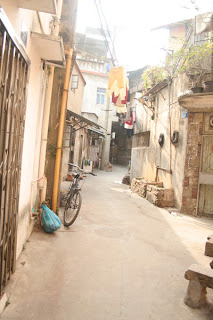Preface: Deepavali has just passed, but, still in the spirit of celebration, I decided to post a somewhat related, an essay which I had done for my CCS (Contemporary and Contextual Studies) 2 months back. It's not an academic essay, although I tried to do something close to that direction. Happy Deepavali!
Frenzy traffic flow which seemed to be totally out of control at times, strong fragrance of jasmine flowers, intermingled with that of spices and incense sticks creeping up your nose from the alleys, loud Indian music blasting through the sound systems in audio CD shops, signage in Tamil scripts all over the area, and countless men and women yakking away in the streets in Tamil or other Indian languages. Sounds like a typical town in Tamil Nadu state of India, but it is not; this is Serangoon, also called “Little India” by the local residents and foreigners alike, well known for its very south-Indian atmosphere. This is very unusual for a country whereby the Indian ethnic group only accounts for 8.8% of the total Singapore population, according to Singapore Department of Statistics
1, and that the Indian population in Singapore is relatively fragmented culturally
2.
 Shophouses with signage in Tamil script; Singapore is one of three countries in the world (other two being India and Sri Lanka) that has Tamil recognised as one of its official language.
Shophouses with signage in Tamil script; Singapore is one of three countries in the world (other two being India and Sri Lanka) that has Tamil recognised as one of its official language.The interesting fact about “Little India” is that this district was not part of the British colony’s plan to make it an Indian enclave as it is today, but was gradually formed due to various events that has taken place in the course of Singapore’s development. At around 1843, after the opening of the Serangoon River, many Indians started flocking to this area after realising that this area is an ideal place for cattle raising, coinciding with the growing importance of the cattle trade then. Also, the employment of Indians as horse trainers at the newly opened Race Course (present day Farrer Park) was also another big factor attracting the Indians to this new district. By1940s, this area became a predominantly Indian district , and has been as such ever since. Especially so after the establishment of the Mustafa Centre in 1995, Serangoon has become the iconic district of the Indian population here.
 A antique and art shop which my friends and I affectionately called it “Indian Art Friend”; not just because it sells many beautiful Indian art works, it shares the same corporate colours with Artfriend.
A antique and art shop which my friends and I affectionately called it “Indian Art Friend”; not just because it sells many beautiful Indian art works, it shares the same corporate colours with Artfriend.The district of “Little India” is bounded by Bukit Timah/ Sungei Road, Serangoon Road, Jalan Besar and Lavender Street. Although the main roads of Serangoon Road and Jalan Besar are where the main concentration of activities takes place, the various small streets and alleys that connect these two roads are bustling with life too. Clive Street and Perak Road are the two less-minor roads that I like most in the whole of the “Little India” district
3. Other than being able to shun away from the crowds of the main roads, the sights and smell of that area are more appealing to me. Over there, stalls selling various kinds of fruits and vegetable can be found; a spectacular visual treat of colours. Although I’m not particularly a fan of vegetable, I like the refreshing smell and these fresh vegetables and fruits. Other than these stalls, there is a number of restaurants selling delicious Indian food, adding to the aroma that is already floating in the air. My favourite Indian eatery outlet happens to be located in this area, and I used to patronise the shop on regular basis for dinner. Although I do not know much about Indian cuisine, but I can tell that the Indian food sold in this outlet taste authentic, quite unlike the typical
roti prata sold at coffeeshops in other parts of Singapore which all tasted the same.
 Typical fruits and vegetable stall in Little India: looks and smells nice.
Typical fruits and vegetable stall in Little India: looks and smells nice.“Little India” is indeed a very unique place in urbanised Singapore, as almost all other places look just like one another, without really much character. “Little India” might be a bit chaotic, especially during the peak periods of the weekends, this district is still an interesting place to visit once a while, to immense oneself into the culture of another ethnic group, to unwind and to relax.
1. http://www.singstat.gov.sg/pubn/reference/sif2007.pdf Singapore Department of Statistics (Singapore In Figures 2007), Jul 2007.
2. Lal, Brij V. The Encyclopedia of the Indian Diaspora. Singapore: Editions Didier Milliet and National University of Singapore, 2006
3. Fun on Foot: Little India, National Heritage Board, http://www.nhb.gov.sg/PE/downloads/funonfoot_littleindia_booklet.pdf




































.jpg)















